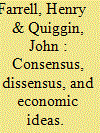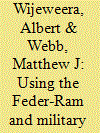| Srl | Item |
| 1 |
ID:
155488


|
|
|
|
|
| Summary/Abstract |
During the recent economic crisis, Keynesian ideas about fiscal stimulus briefly seemed to form the basis of a new expert consensus about how to deal with demand shocks. However, this apparent consensus soon collapsed into a continuing dissensus, with important consequences for policy. Neither conventional bargaining accounts nor existing theories of the role of ideas in policy outcomes easily explain the arc of international responses to the Great Recession. In this article, we propose that sociological arguments about professions, in conjunction with those about spaces of political contention as ecologies, provide a better understanding of the puzzle of Keynesianism’s rise and decline. The internal dynamics of prestige and status within the profession of economics intersected with policy arguments between states so as to make macroeconomic policy a “hinge” issue, over which coalitions in both ecologies contended. This explains how Keynesian economists and political actors worked together in the first phase of the crisis to advocate for and implement fiscal stimulus. It also explains why aggrieved policy actors, who did not favor stimulus, could help disrupt the apparent consensus in the second phase of the crisis by promoting the views of dissident economists.
|
|
|
|
|
|
|
|
|
|
|
|
|
|
|
|
| 2 |
ID:
112393


|
|
|
|
|
| Publication |
2012.
|
| Summary/Abstract |
This study uses the Feder-Ram model in conjunction with the military Keynesian model to examine the nexus between defence spending and economic growth in Sri Lanka. We find that the Keynesian aggregate demand model is better suited to analyse the link than the Feder-Ram model for the case of Sri Lanka. Based upon our results we expect a higher economic growth rate in Sri Lanka if more public resources are diverted from the defence to civilian sectors of the economy, now that the war between the government and separatist guerrillas has come to an end. However, recent post war events cast doubt upon whether a diversion of sources from military to non-military spending will actually occur. We conclude that the sanguine predictions of our economic analysis are entirely dependent upon the political decisions of the Sri Lankan government for their realization.
|
|
|
|
|
|
|
|
|
|
|
|
|
|
|
|